As in previous years (2014 and 2015), I’m offering up the journal I use to keep track of maintenance, progress, and changes to our Fluval Spec V aquarium. It is a lot of repetitive entries for the most part. The big events included adding pressurized CO2 (on 2016/11/08) and subsequent rescape with new plants. I have in the past documented every dosing of EI fertilizers, which in the low-tech version of this tank was a weekly event. The transition to high-tech with pressurized CO2 means daily EI fertilizer doses; I don’t record each day anymore.
I hope you can see the benefit of keeping an aquarium journal with these entries. It really does help me see where I have been with adjustments and that helps me plot the course for any future changes:
Our Nano Journal 2016
1/2/16:
Dose 1/32 tsp (‘smidgen’) of csm + b dry.
1/17/16:
50% water change. Rinsed out filter media and vacuum water from filter section.
Dosed 1/16 Teaspoon (pinch) of KNO3 (Potassium Nitrate); Dosed 1/32 Teaspoon (‘smidgen’) of KH2PO4 (Potassium Phosphate); Dosed 1/32 Teaspoon (‘smidgen’) of K2SO4 (Potassium Sulfate.
1/18/16:
Dose 1/32 tsp (‘smidgen’) of csm + b dry.
1/30/14:
50% water change. Rinsed out filter media and vacuum water from filter section.
Removed, trimmed, re-glued, and replanted most of the annubias nana petite.
Dosed 1/16 Teaspoon (pinch) of KNO3 (Potassium Nitrate); Dosed 1/32 Teaspoon (‘smidgen’) of KH2PO4 (Potassium Phosphate); Dosed 1/32 Teaspoon (‘smidgen’) of K2SO4 (Potassium Sulfate.
2/3/16:
Dose 1/32 tsp (‘smidgen’) of csm + b dry.
2/21/16:
Noticed we are down to four green neons. Might have been me gone to the men’s retreat and they didn’t eat for 3 days. Could be that I haven’t changed the water in three weeks.
2/22/16:
50% water change. Rinsed out filter media and vacuum water from filter section.
Trimmed a bunch of Cryptocoryne Undulata. The tank was very dirty with algae on the glass and tons of detritus in the filter.
Dosed 1/16 Teaspoon (pinch) of KNO3 (Potassium Nitrate); Dosed 1/32 Teaspoon (‘smidgen’) of KH2PO4 (Potassium Phosphate); Dosed 1/32 Teaspoon (‘smidgen’) of K2SO4 (Potassium Sulfate.
2/29/16:
Dose 1/32 tsp (‘smidgen’) of csm + b dry.
3/10/16:
50% water change. Rinsed out filter media and vacuum water from filter section.
Removed almost all the Bacopa Caroliniana to trim and replant.
Dosed 1/16 Teaspoon (pinch) of KNO3 (Potassium Nitrate); Dosed 1/32 Teaspoon (‘smidgen’) of KH2PO4 (Potassium Phosphate); Dosed 1/32 Teaspoon (‘smidgen’) of K2SO4 (Potassium Sulfate.
3/11/16:
Dose 1/32 tsp (‘smidgen’) of csm + b dry.
3/24/16:
50% water change. Rinsed out filter media and vacuum water from filter section.
Dosed 1/16 Teaspoon (pinch) of KNO3 (Potassium Nitrate); Dosed 1/32 Teaspoon (‘smidgen’) of KH2PO4 (Potassium Phosphate); Dosed 1/32 Teaspoon (‘smidgen’) of K2SO4 (Potassium Sulfate.
Still have 5 fish.
3/25/16:
Dose 1/32 tsp (‘smidgen’) of csm + b dry.
(mid april – water change and fertilizers)
5/10/16:
50% water change. Rinsed out filter media and vacuum water from filter section.
Dosed 1/16 Teaspoon (pinch) of KNO3 (Potassium Nitrate); Dosed 1/32 Teaspoon (‘smidgen’) of KH2PO4 (Potassium Phosphate); Dosed 1/32 Teaspoon (‘smidgen’) of K2SO4 (Potassium Sulfate.
5/11/16:
Dose 1/32 tsp (‘smidgen’) of csm + b dry.
6/1/16:
50% water change. Rinsed out filter media and vacuum water from filter section.
Dosed 1/16 Teaspoon (pinch) of KNO3 (Potassium Nitrate); Dosed 1/32 Teaspoon (‘smidgen’) of KH2PO4 (Potassium Phosphate); Dosed 1/32 Teaspoon (‘smidgen’) of K2SO4 (Potassium Sulfate.
6/4/16:
Dose 1/32 tsp (‘smidgen’) of csm + b dry.
6/29/16:
50% water change. Rinsed out filter media and vacuum water from filter section.
Dosed 1/16 Teaspoon (pinch) of KNO3 (Potassium Nitrate); Dosed 1/32 Teaspoon (‘smidgen’) of KH2PO4 (Potassium Phosphate); Dosed 1/32 Teaspoon (‘smidgen’) of K2SO4 (Potassium Sulfate.
6/30/16:
Dose 1/32 tsp (‘smidgen’) of csm + b dry.
7/18/16:
50% water change. Rinsed out filter media and vacuum water from filter section.
Thinned down the Cryptocoryne Undulata and trimmed a few of the Bacopa Caroliniana stems.
Dosed 1/16 Teaspoon (pinch) of KNO3 (Potassium Nitrate); Dosed 1/32 Teaspoon (‘smidgen’) of KH2PO4 (Potassium Phosphate); Dosed 1/32 Teaspoon (‘smidgen’) of K2SO4 (Potassium Sulfate.
7/19/16:
Dose 1/32 tsp (‘smidgen’) of csm + b dry.
8/1/16:
50% water change. Rinsed out filter media and vacuum water from filter section.
Dosed 1/16 Teaspoon (pinch) of KNO3 (Potassium Nitrate); Dosed 1/32 Teaspoon (‘smidgen’) of KH2PO4 (Potassium Phosphate); Dosed 1/32 Teaspoon (‘smidgen’) of K2SO4 (Potassium Sulfate.
8/2/16:
Dose 1/32 tsp (‘smidgen’) of csm + b dry.
9/6/16:
50% water change. Rinsed out filter media and vacuum water from filter section.
Heavy trim of Cryptocoryne Undulata
Dosed 1/16 Teaspoon (pinch) of KNO3 (Potassium Nitrate); Dosed 1/32 Teaspoon (‘smidgen’) of KH2PO4 (Potassium Phosphate); Dosed 1/32 Teaspoon (‘smidgen’) of K2SO4 (Potassium Sulfate.
9/7/16:
Dose 1/32 tsp (‘smidgen’) of csm + b dry.
10/7/16:
50% water change. Rinsed out filter media and vacuum water from filter section.
Trimmed tops of Bacopa Caroliniana and replanted to make more stems.
Dosed 1/16 Teaspoon (pinch) of KNO3 (Potassium Nitrate); Dosed 1/32 Teaspoon (‘smidgen’) of KH2PO4 (Potassium Phosphate); Dosed 1/32 Teaspoon (‘smidgen’) of K2SO4 (Potassium Sulfate.
10/8/16:
Dose 1/32 tsp (‘smidgen’) of csm + b dry.
10/24/16:
50% water change.
I still don’t have the fitting for our new kitchen faucet to use the python water changer, so I did this water change by scooping water out with tupperware and refilling (didn’t rinse filter media).
Dosed 1/16 Teaspoon (pinch) of KNO3 (Potassium Nitrate); Dosed 1/32 Teaspoon (‘smidgen’) of KH2PO4 (Potassium Phosphate); Dosed 1/32 Teaspoon (‘smidgen’) of K2SO4 (Potassium Sulfate.
10/25/16:
Dose 1/32 tsp (‘smidgen’) of csm + b dry.
11/8/2016:
Installed pressurized CO2 system. Set the needle valve to 33 bubbles per minute.
Changed the lighting schedule from 2 segments per day (morning and evening) to one segment: 12:30 pm to 8:30 pm.
CO2 comes on at 11:30 am and shuts off at 7:30 pm.
11/9/2016:
50% water change. Rinsed out filter media and vacuum water from filter section.
Thinned out Cryptocoryne Undulata; trimmed and replanted some Bacopa Caroliniana.
Starting on dosing regimen for EI of a high tech aquarium. I won’t record every time I dose, but will stick to the following (unless I change):
Mon. Wed. Fri. = 1 Drop CMS+B
Tues. Thurs. Sun. = 1 smidgen-KNO3, 1 Drop KH2PO4, (Optional 1 Drop K2SO4)
11/11/2016:
CO2 is at 28 bubbles per minute.
11/12/2016:
setup quarantine tank. Break down aquarium and clean out.
11/13/2016:
Rescape aquarium. Setup with new rocks (no wood) and all new up aqua aquasand.
11/16/2016:
Plant aquarium with new: blyxa japonica, rotala indica green (rotundifolia ?), staurogyne repens, and hemianthus callitrichoides (aka HC, aka dwarf baby tears).
11/16/2016:
Moved fish and shrimp back into the tank. One fish seemed gassed from the CO2; they all survived.
Start EI dosing in new tank as follows:
Mon. Wed. Fri. = 1 Drop CMS+B
Tues. Thurs. Sun. = 1 smidgen-KNO3, 1 Drop KH2PO4
11/17/2016:
43 bubbles per minute of CO2
11/26/2016:
Back from thanksgiving vacation – tank did well! Rotala Green grew a lot. HC is starting to spread. No algae.
50% water change. Rinsed out filter media.
11/27/2016:
added elbow fittings to CO2 system.
47 bubbles per minute of CO2
12/2/2016:
I keep fiddling with the CO2 valve.
39 bubbles per minute of CO2.
I turned it up a bit.
12/3/2016:
50% water change. Rinsed out filter media.
Took out the remaining plants from the old setup (two stems of bacopa caroliniana, annubias, cryptocoryne parva). Trimmed plants including the HC.
12/10/2016:
Some algae is forming slowly on the rocks and glass – I think it’s green spot (GSA).
Adjusted the CO2 up to 69 bubbles per minute.
12/11/2016:
50% water change. Rinsed out filter media.
Trimmed rotala; cut a few tops of staurogyne repens and replanted to bare place.
Miles came in this morning and alarmed me that a fish had jumped out. I thought it would be dead bur turned out it just happened. scooped up and put it back in. Still have 5 fish alive tonight.
12/16/16:
50% water change. Rinsed out filter media.
Trimmed bits of everything.
12/18/2016:
Checked CO2: 66 BPM
12/21/2016:
Starting to see green spot algae on glass and rocks. Also seeing black beard algae on front rock.
Increased CO2 to 80 BPM.
12/22/2016:
50% water change. Rinsed out filter media.
Trimmed HC and rotala.
Setup auto feeder. Tripled EI dosing on 23rd and 24th as we are leaving town until 1/2/2017.


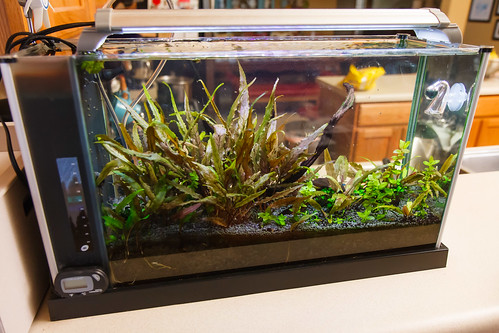
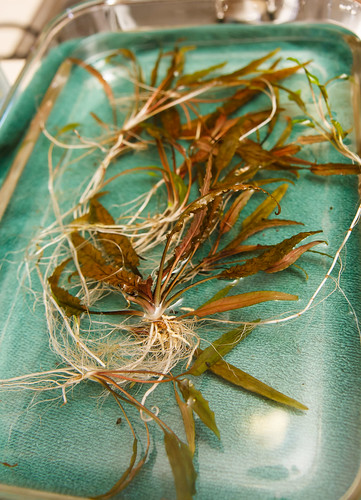
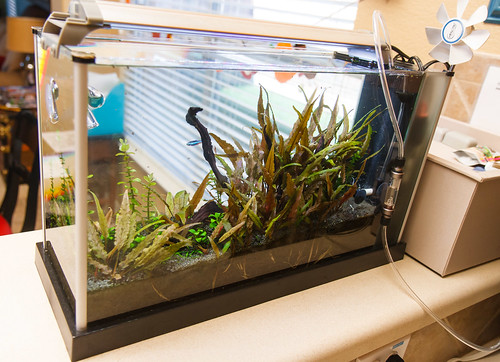
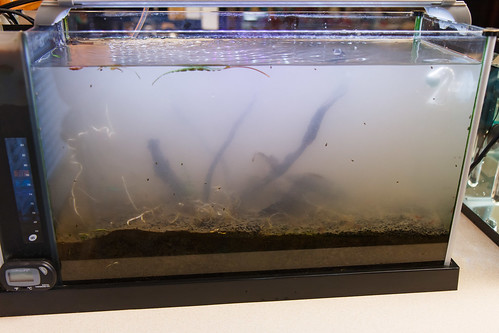
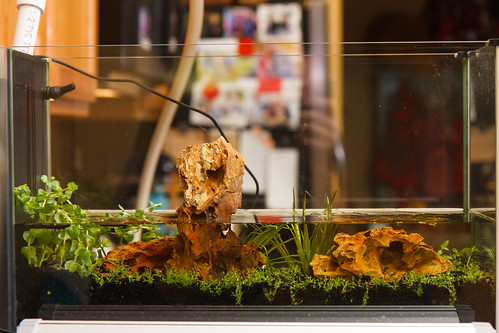
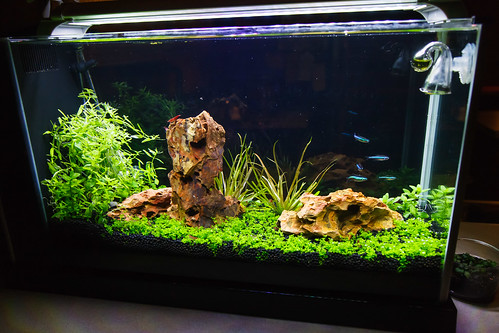

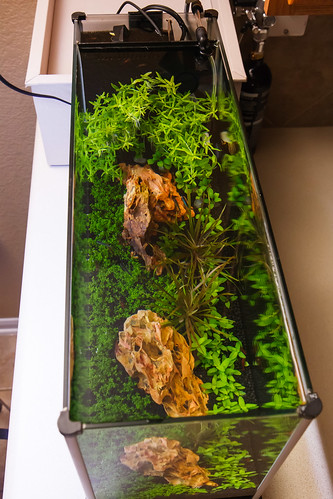

Thanks for sharing. I’m just getting the CO2 set up on my Spec V, myself. I’ve started at a much lower bubble rate based upon some calculations I found in a forum. (1 bubble every 8 seconds). I’m a bit concerned about my acidity as I’ll be keeping Endlers livebearers in this tank and with the substrate my pH hovers about 6.4. I’ve been using the Seachem Alkaline and Neutral regulator to try to get the pH around 7.3-7.5 in anticipation of the fish arriving. How are you finding that CO2 level working? I’m around that bubble rate in my 32 gallon, although I’ve converted a Biocube to freshwater and need to replace the LEDs, have nuisance algae all over the place.
There is no way to correlate bubble count from one setup to another. Best bet is to observe your fish and plants as you make adjustments. Also, know that the rate you put CO2 in may change as your tank changes; if it fills in with heavy plant growth, you may be justified to increase it. My bubble count today is higher than what is indicated in this journal.
Thanks for the reply. That’s very interesting. I’m finding the drop checker to be useless – it develops a nasty film after a day. I’m also finding differences in the bubble counters. The Aquatek mini I have on the big tank came with that integrated check valve one. Didn’t realize how nice that feature was until I set up the Fluval 88g on the Spec V with a regular bubble counter…practically sucked half the water back out of the counter when the solenoid turned off. I’m finding a lot of this is ultimately coming down to trial and error. Like you said, no two setups are the same. I look forward to seeing updates of your tank growing with the CO2.
Increase the carbonate hardness, not the alkaline.
Hi there! I’m about to purchase 2 fluval spec Vs and I just wanted to say that coming across your site is the best thing that has happened to me in my modification research! I really appreciate all the work you have put into this project. I will def be using your amazon link to purchase a few things when I’m ready.
I appreciate that – thanks!
Love your site! Wish I would’ve found it before now. You’ve got some really brilliant ideas such as the holes in the pump output tube. I immediately did the same to my tank. Before I had just thrown an air stone down there, can’t believe I never even thought of just making my own holes for better circulation.
I’ve had my spec v for a couple years now and love it except one small caveat. I’ve always battled with high nitrates in this tank. No matter the occupants, planted or not planted. I know it’s not stemming from my tap water as I’ve tested it and my larger 55 gallon tank doesn’t have this issue. Just to keep the nitrates in check I have to do 50% water changes twice a week. Luckily the cherry shrimp I have in there are incredibly resilient. I’ve looked for and tried to find what’s causing this issue but to no avail. I’m wondering if you might have some insight to help me with this nitrate problem.
At this point I’m thinking of removing all critters and just using it as a planted only tank, to grow out some young plants and move them over to my big display tank. At least then I won’t have to worry about nitrate poisoning my shrimp.
Off the top of my head, I can’t think of a reason to have elevated Nitrates. Can you tell me how heavily your tank is loaded (numbers of fish / shrimp)? Also, what is your nitrates testing at (ppm)?
Fauna in the aquarium about 12-13 cherry shrimp and a Mexican cpo crayfish, all under 2.5 cm in length. Max size on that crayfish is 4 or 5 cm btw. No fish. I feed sparingly, usually the night before a water change. I would call the tank modestly planted.
I use the API test kit and it’s difficult to tell a difference between 40 and 80 ppm, but by day three after a water change the test comes out definitely red, no orange color left at all. So I split the difference and call it 60 ppm and promptly do a water change.
At this rate, I’ll probably just keep doing the same schedule I’ve been doing. I’ve only lost two of the shrimp and that was in the first couple days that I had them. Don’t fix what ain’t broke I guess.
One Spec V owner to another, and I know there’s a million and one different things that affect nitrate accumulation, what’re your readings on nitrate after three days if you don’t mind my asking?
I don’t test anymore. Haven’t tested anything in years. From when I was testing, I know that 50% water changes weekly keep it inline. I think I remember testing around 20 to 40 ppm.
Hi Nate. Thank you for the hard work you put into all this. I hope you don’t mind but I put a link to your site on my AMAZON review for the tank and on the Q and A.
sounds good – thanks!